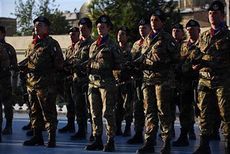 Counter-insurgency warfare is meant to be different from traditional war-fighting in one particular way: it recognises the military’s limitations. It accepts that soldiers may be able to fight off insurgents, but only reconstruction in, and outreach to, local communities can stave off renewed conflict. In that way, counter-insurgency is based on getting civilians to play an active role.
Counter-insurgency warfare is meant to be different from traditional war-fighting in one particular way: it recognises the military’s limitations. It accepts that soldiers may be able to fight off insurgents, but only reconstruction in, and outreach to, local communities can stave off renewed conflict. In that way, counter-insurgency is based on getting civilians to play an active role.
But despite this new military orthodoxy, and some four years after the Taliban began its fight-back against NATO’s Afghan mission, the number of civilians deployed into theatre has been disappointingly low. Neither the US nor Europe have dispatched the hundreds of development specialists seen as crucial for success. In Europe, the problem is not only a question of political will and, lately, a worry that the Obama administration has no stomach for a drawn-out fight. It is also down to a severe lack of civilian capacity.
Of the 11,112 people reported by European governments in 2008 as ready for missions, only 1,928 were deployed. From Kosovo to Iraq, ESDP missions struggle to deploy civilian specialists. Diplomats privately admit that the drive to staff the EU’s largest mission, the 1800-strong EULEX in Kosovo, has drained the pool of deployable personnel. This has left other missions, like the EU’s police programme in Kabul, suffering. With the economic crisis putting new pressure on national budgets – Britain, for example, is cutting 30-40 percent of its seconded posts – recruiting civilians is only going to get a lot harder.
In the first-ever assessment of the civilian capabilities of the 27 European states, Richard Gowan and I examined a range of criteria beyond simply the numbers of people being deployed. We concluded that the majority of countries suffer from a “counterinsurgency gap,” having failed to put in place bureaucratic systems to recruit, train and deploy civilians into military-run theatres.
Not everyone is bad as each other. Four different categories of countries emerge in the study. Countries that take civilian capacities seriously can all be found in a crescent that arcs across the northern-western part of the continent. This takes in Britain, the Netherlands, Denmark, Germany, Sweden and Germany. Of these, Britain is probably the European pioneer. The way it recruits civilians and plans missions has been copied by the Netherlands and Denmark.
Below this group of high-achievers are a set of countries that seem keen to build civilian capabilities but have yet to make the necessary investment, such as enhancing civilian rosters, strengthening the recruitment processes and improving training. Together, countries in this group – which includes Austria, Belgium, France, Ireland, Italy and Romania – have reported 3,916 civilians and police officers available for European deployments, but deployed only 790.
Many southern and eastern European countries, however, appear unconvinced about the value of civilian deployments. The Czech Republic, Hungary, Poland, Portugal, Slovakia, Slovenia and Spain all report poor inter-ministerial cooperation, and admit that civilian crisis management does not enjoy a high level of political visibility. Spain has met only 2.8 percent of a deployment pledge it made to its European allies in 2008 to fellow allies – making it the guilty of the biggest broken promise in this area.
If counter-insurgency missions are the way of future warfare – and if they will likely fail without the necessary civilian in-put – then building civilian capacities across the twenty-seven European states should be a security policy priority.






Comments